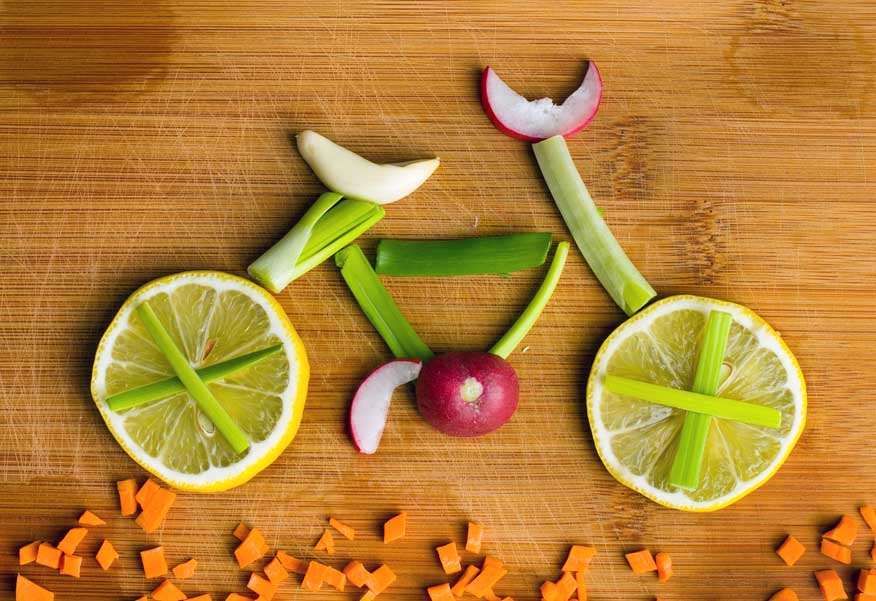
By
Sometimes, we all need a little nudge of motivation towards making healthy changes to our lifestyle and our diet.
The motivation can be as simple and straight forward as losing weight, or just being healthy to live a long and prosperous life. The motivation and the desire may come easy for those who do not have the burden of keeping their blood sugar levels in constant check. But when you have type 2 diabetes, you suddenly have so much more to think about.
It can be quite overwhelming and daunting to make appropriate decisions to stay on track when it comes to your nutrition and diet.
It could also be that you have no idea what little changes to make in order to manage your diabetes.
Fear not because we asked 51 registered dietitians to share lifestyle and dietary tips for those with type 2 diabetes.
Please read below to find out what they have to say to make your life a little less complicated.
[accordions id=”6203″]
1. Ellen Ratliff, RD
 Aim for a consistent amount of carbohydrates at each meal, focusing on complex sources such as whole grain breads, pastas, and cereals, brown rice, beans, whole fruit, and low-fat dairy. Remember to incorporate small snacks if you are going longer than 4 hours between meals.
Aim for a consistent amount of carbohydrates at each meal, focusing on complex sources such as whole grain breads, pastas, and cereals, brown rice, beans, whole fruit, and low-fat dairy. Remember to incorporate small snacks if you are going longer than 4 hours between meals.
I advise reading the following articles:
Also, do not underestimate the role that exercise can play in lowering blood sugar, such as brisk walking. Check your blood sugar before and after exercise to make sure it does not go too low and have a quick source of carbohydrates on hand if you are away from home, such as in your purse or in the glove box of your car. If you are having trouble controlling your blood sugar, many insurance plans cover visits to a registered dietitian and/or certified diabetes educator. Ask your doctor for a referral or search on eatright.org to find a registered dietitian near you.
2. Lisa R Young, PhD, RD

Having spent the past 20 plus years as a registered dietitian counseling patients with diabetes, here are my top picks:
1. Portions, portions, portions!
Practicing portion-control is, in my opinion, one of the simplest and most effective ways to manage diabetes (and shed unwanted pounds if you are also overweight).
Practicing portion control enables you to eat foods from all the food groups, just in healthy portions. I recommend using a healthy plate as your guide: half the plate fulled with veggies, 1/4 filled with lean protein and 1/4 filled with a high fiber, healthy starch (think quinoa, brown rice).
By practicing portion control, you get to eat the foods you love (just not huge amounts every day) without cutting out certain food groups entirely.
2. Write it down.
Keeping a food diary is a great way to see what (and how much) you are eating so that you can compare it to how you feel. Monitoring what you eat helps to keep you mindful and make sure you are following your program.
Today, there are so many good apps on the phone if you don’t want to use the old fashioned approach. All methods work; just do it!
3. Include fiber and protein to each meal.
Fiber and protein help you feel full while also stabilizing blood sugar, a winning combo for diabetics. Choose whole grains instead of white bread products and include healthy proteins, such as grilled fish or chicken, eggs, or beans.
4. Move more.
Try to exercise most days of the week.
Exercise will help keep your blood sugar in check, your weight down, while also improving your mood.
3. Janet Zarowitz, MS, RD, CDN

Many of my type 2 diabetic patients prefer to keep their blood sugar levels within a healthy zone, without the use of medication. I work with them on food and lifestyle first and evidence-based nutrition supplement strategies second. Naturally, I coordinate with the patient’s medical doctor.
Here’s a great example. There’s very good scientific evidence that berberine, a compound found in plants like European barberry, goldenseal and Oregon grape, might be just as effective in controlling blood sugar in type 2 diabetics as prescription medicines like metformin or rosiglitazone.
Another example is an antioxidant naturally found in our bodies, – alpha-lipoic acid or ALA. We make it and get some from foods like red meat, organ meats like liver and brewer’s yeast. There’s strong research evidence that ALA improves blood sugar levels in type 2 diabetics.
4. Amy Gonzalez, RD, LD, NTP
My number one diet tip is to balance every meal with protein, fat, and carbohydrate. Many times a low-fat diet is encouraged to reduce the risks of cardiovascular disease but we are not told that our bodies require healthy fat to create healthy hormones, absorb fat-soluble vitamins, provide a long-burning source of energy, and also provide satiety while stabilizing blood sugar swings. Healthy fats like nuts, seeds, coconut oil, olive oil, fatty fish, avocados, full fat dairy also help keep blood sugar levels in check when the meal is balanced properly.
When it comes to lifestyle, the best suggestion I have for those with diabetes is to practice self-care. It’s nearly impossible to regulate blood sugar levels without managing stress. Chronic stress, whether emotional or physical (i.e. poor diet, lack of movement, being stuck in traffic, or preparing for a deadline) will elicit a response of cortisol, which can disrupt blood sugar levels. While avoiding stress is not realistic, what we can do is work on our response to stress. Getting outside in nature, journaling, baths, exercise, reading, prayer, and meditation are all great ways to relax and care for you!
5. Lindsay Wexler, RDN,CSSD
Top 5 Lifestyle and Dietary Tips:
- Don’t let carbohydrates stand alone. Combine lean proteins with your carbohydrates to help maintain a steady blood sugar level.
- Move! Regular exercise is extremely important to control your weight and blood sugars. Physical activity doesn’t have to be rigorous, just move your body through space. Schedule time in your day to get at least 30 minutes in.
- Stay positive. Stress and negativity can reap havoc on your body, and are no friend to blood sugars. Start your day with positive thoughts. Find ways to cope with stress that work for you.
- Never skip meals. Skipping meals can drop your blood sugars cause a roller coaster like affect on your levels. Our main goal is to keep your blood sugars as stable as possible during the day, ideally eating every 4-5 hours.
- Forbid having forbidden foods. Allow yourself the occasional treat, occasionally! Do still be ware of the portion size and carbohydrate load in it.Try not to go over 60g in a sitting.
6. Paul Jefcoate
Whether you have just been diagnosed with type 2 diabetes or you’ve been living with it for a number of years, choosing what to eat and drink might seem a little daunting. Especially if you’re unfamiliar with how certain foods and drinks affect your blood glucose levels.
My top tips would be to:
- Take time to learn about your condition, discover what influences your own blood glucose levels and practice the skill of portion control to reduce rapid spikes in your blood glucose levels.
- Listen to your body’s signals:
- “Am I hungry?” Monitor when you are eating. Is it when you are genuinely hungry, or are you eating for a different reason, e.g. boredom.
- “Am I full?” Pay attention to your reducing hunger levels when you are eating, if you are distracted by something it’s more likely your body signalling it’s full will go unnoticed.
- “What happens to my blood glucose levels when I eat X, Y and Z.” Monitoring these will enable you to develop a long term diet plan that is effective for controlling your diabetes.
- Introduce wholegrain based carbohydrates gradually to reduce the risk of potential symptoms like bloating, stomach cramps and diarrhoea. A diet inclusive of wholegrain carbohydrates are advantageous for diabetes management because foods with a lower glycemic index are absorbed slowly and a diet high in fibre will keep you feeling full for longer.
- Be prepared daily – make sure you carry a snack with you, so if you experience low energy levels you have something to hand that you know is not going to affect your blood glucose levels too dramatically. Good examples would include a portion of fruit, veggie sticks or a handful of nuts.
- Get active – Keeping active can be a great way of managing type 2 diabetes. Find an activity that you love and incorporate it into your lifestyle. It’s best to build up your activity levels gradually to allow your body to adjust to your new lifestyle change.
7. Hope Warshaw, MMSc, RD, CDE, BC-ADM
It’s darn hard and unrelenting work to make healthy food choices and practice healthy eating habits. Here are a few tips I routinely follow. While I don’t have diabetes I work hard to maintain a healthy weight and live a healthy lifestyle.
- Prepare (even if simply assembling) meals at home as much as possible. You’ll generally eat more vegetables, smaller portions, less fat, fewer total calories.
- Use weekend or evening time to chop, chop fruits and vegetables in bulk. You’ll be more likely to eat more servings of these healthy foods. Check out this blog to see how I’ve done this for years now.
- When you eat restaurant meals, practice portion control from the point when you order. Order from salads, soups, appetizers or split and share portions. You can do this from fast food meals to ethnic restaurants (even easier in many) to haute cuisine. Get less food placed in front of you to eat less and fewer calories. Yes, practice portion control.
8. Lila Ojeda, MS, RDN, CSCS, RYT, CLT
1. Eat a variety of foods at each meal. This will help you get all the nutrients you need while maintaining more constant blood sugar levels. Combining foods like complex high fiber carbohydrates (whole grains, fruits, veggies, lentils/beans) with protein foods (lean meat, fish, poultry, nuts, low-fat dairy) will help avoid high spikes in blood sugars. Remember to eat a variety of colors for antioxidants and anti-free radical properties. Color and variety truly are the spice of life when it comes to diabetes and overall health and vitality.
Not so good meal/snack Better Meal”
- hot cereal mixed with water * hot or cold cereal with skim milk or a healthy protein powder (ideally plant based)
- chips and soda * burrito (whole grain small tortilla, beans, rice, lean meat)
- fruit * fruit and cottage cheese or egg whites for protein
- graham crackers * graham crackers and skim milk
2. Eat a balanced diet that is moderate in calories and low in fat. Decrease your total fat and saturated fat intake too. Yes, this is still true – the TYPE of fat and the AMOUNT does matter, no matter what mass media tries to say. Focus on avocado, nuts in moderation, good oils like olive oil, and low fat to nonfat dairy. Remember fat has twice as many calories as carbohydrates and protein so if you need to lose weight, fats can add up in unwanted excess calories. Fats ARE great for us, just pick and choose the right ones.
3. Do not skip meals. Eat at least 3 meals a day with 2 snacks spaced evenly throughout the day. Eat at the same time each day to help maintain even blood sugar levels. Depending on activity levels and medication, snacks are often beneficial between meals and at bedtime, or before and after activity. Many people try NOT to eat so they can save calories or eat larger meals later. Often diabetics think they shouldn’t eat when blood sugars are too high – not true. To maintain proper blood sugar levels and energy we all need to eat every 3 hours. Longer than 4 hours without food can be quite hard on the body and blood sugars. It’s like a mixed message to the body.
4. Count your carbohydrates. True: The amount of carbohydrate is more important than the type of carbohydrate in blood sugar response. Simple sugars (table sugar, brown sugar, high fructose corn syrup, honey, etc.) and complex carbohydrates (breads, whole grains, fruits, rice, pasta, potatoes) are known to cause a similar response in blood sugars but of course healthier foods are the way to go when it comes to health. Remember, it’s all about the portions. Choose complex carbohydrates because they contribute greater nutritional value and should build the foundation of a healthy diet. TIP: 1 carbohydrate=15 grams on the label. Depending on calories needs, meals should be ~4-5 carbohydrates and snacks ~1-2 carbohydrates. Please see a Registered Dietitian Nutritionist to help personalize this for your body, goals, and overall caloric needs. I see clients remotely: www.LO-Solutions.com
5. Stay active! Exercise can help to maintain a healthy weight and help you feel more positive overall. It also maintains healthy blood sugar levels. Try to do something active at least 30 minutes a day. If it’s more convenient, this can be broken up into 3 sessions of 10 minutes, or 2 sessions of 15. As long as the intensity is the same, similar benefits are obtained. Sure longer might be “better” but do was you can and add onto so it’s sustainable. If you shoot too high it can cause you to give up all together. When you exercise, your body uses blood sugar better without added medicine. I’ve been using and helping clients use step counters (pedometers/fit bits) since 2003. It can be a great motivational and fitness tool when used properly. Simply wearing it doesn’t count. tee hee 
9. Megrette Fletcher M.Ed., RD, CDE
Asking “Am I Hungry?” before eating can help you determine if you are physically hungry, eating out of habit or because of emotion. The “Aha!” moment which is realizing, “Sometimes I eat when I am not hungry.” We all do it! So what do you do then? If hunger not present, don’t jump on the blame train! Remain curious and ask, “If it isn’t because of hunger, why am I eating?” There are lots of reasons why someone eats, which is why rigid diets and strict food rules don’t work. Let mindful eating can help you untangle your thoughts and feelings about diabetes, self-care, and eating by asking a single question — “Am I Hungry?”
10. Lucia Weiler BSc, RD
Diabetes and PRE Diabetes affect many people. If you have diabetes or PRE-diabetes you know that managing the condition is key to your health and wellness. This however can be overwhelming and some people aren’t sure where to start or how to get back on track. The good news is that type 2 diabetes can be prevented or delayed with appropriate lifestyle changes. [1]
Food is a key component in managing diabetes so having a dietitian as part of your care team will help you achieve your health goals.[2] There is not a simple ‘one-diet-fits’ all approach. A dietitian is a credible trusted nutrition expert who works with you to meet your individual goals. Here are 5 tips to help you manage diabetes:
- Focus on small gradual dietary changes that you can stick with.
- Keep portion sizes in check. Consider the plate method – making half your plate veggies.
- Understand carbohydrates – it’s not just sugars, but starch also breaks down to sugars!
- Monitory your blood sugar levels.
- Trust a Registered Dietitian with your nutritional health. You can DO IT, ask for help when you need it.
REFERENCES:
1. Today’s Dietitian (2017)
2. Dietitians of Canada Nutrition Month (2017)
11. Wendy Kaplan, MS, RDN, CDN
First tip – don’t get your health and nutrition information from random sources on the internet! With the right guidance (from a Registered Dietitian Nutritionist and Certified Diabetes Educator) following a healthy diet and lifestyle can have a huge positive impact on people with type 2 diabetes.
I work with cancer patients and unfortunately diabetes is not uncommon, possibly even as a result of the cancer treatment itself. My advice stems from solid science, eat mostly a plant-based diet, like fruits, vegetables, beans, legumes and whole grains, include exercise in your daily routine (ideally 30 minutes or more a day) and limit your consumption of sugary, salty and fatty foods.
There is no magic bullet or a one size fits all prescription, so it is imperative that a plan be customized to meet your individual needs. Goals set need to be achievable and attainable so that learned healthy lifestyle and dietary habits will become a permanent fixture.
Lastly, set yourself up for success by prepping meals for the week. The more prepared you are going into the week, the less obstacles you will face!
12. Kim Francis RD, LDN
Eating well and exercising is the foundation to living a healthy lifestyle. From my clinical experience when someone is newly diagnosed with type 2 diabetes or has uncontrolled diabetes it can be a mission impossible to eat well, exercise, and maintain acceptable blood sugar values. Typically, when counseling a client with type 2 diabetes, I like to discuss 3 essential survival tips to build a healthier lifestyle. Here is what you need to know:
1. C-A-R-B-O-H-Y-D-R-A-T-E-S
The first survival topic I typically address is a thirteen-letter word most people seem to be afraid of: C-A-R-B-O-H-Y-D-R-A-T-E-S! Carbohydrates are the body’s preferred source of energy and it has the greatest impact in altering blood sugar values. Carbohydrates can be found in fruits, dairy products, starchy vegetables, and processed foods such as candies and cake, to name a few. Eating too many carbohydrates can raise the blood sugar, while eating too little carbohydrates can have the opposite effect. Clients should work with a physician and/or dietitian to know the proper quantity of carbohydrates to be consumed each meal.
2. Tick-Tock
Meal timing and spacing is the second survival topic someone with type 2 diabetes needs to know. It is a best practice to try to eat around the same time daily and not skip meals. Depending on what medications you are on, skipping meals or can cause hypoglycemia or lower your blood sugar to an unsafe level. Some signs of hypoglycemia include hunger, weakness, and shakiness. In the case you cannot eat a meal it is best to carry a carbohydrate snack to prevent hypoglycemia and keep blood sugar levels in a safe range.
3. Exercise
Exercising is the final survival topic for living a healthy lifestyle. For someone with type 2 diabetes exercising helps to lowers blood sugar values and can continue do so hours after exercising. It is best for someone with type 2 diabetes to check their blood sugar before, during, and after exercise to make sure their blood sugar is not too high or too low. Though beneficial, it is best to speak with a physician prior to beginning an exercise regimen to ensure exercising is not contraindicated.
13. Lisa Moskovitz, CEO, RD, CDN, CPT
- Limit added sugars to no more than 10% total calories. If you’re consuming a 1600 calorie diet this is no more than 40g per day. Added sugars are mostly found in processed foods, sweetened beverages, sweetened cereals/snack foods, certain condiments, etc.
- Increase soluble and insoluble fiber – aim for at least 25-30g/day. Fiber-rich foods include bran, oats, beans, fruits, vegetables, nuts, seeds. Fiber helps with digestion and break down of carbohydrates into sugar in your blood. Higher fiber diets tend to be lower glycemic and keep blood sugars stable.
- Aim for at least 2-3 liters of water per day. This will help keep you hydrated and keep appetite/hunger in check. Have at least 2 glasses of water first thing in the morning and 1 glass (8 oz) BEFORE every meal and snack. Limit drinking liquids with meals as it can prevent food from being chewed properly if you drink while eating. Add fresh lemon or cucumbers to spruce it up, add additional nutritional value, and make it more appealing.
- Aim for at least 30 minutes of moderate-intensity exercise 5 days per week. Up to 60 minutes 5 days per week is deal for weight loss. Incorporate different types of exercises such as aerobic classes, cardio machines, and lifting weights. Invest in a personal trainer to teach you some basic exercises if you need it.
- Incorporate plenty of anti-inflammatory and antioxidant-rich foods into diet such as green tea, berries, chia seeds, dark leafy greens, avocado, olive oil, turmeric powder, cinnamon powder, etc. You don’t need to eat all of these foods everyday but gradually add in 1 or 2 per day and then alternate with different foods for variety. Try to be consistent.
- Cook ahead of time for the week so that you don’t rely on outside food sources. It can be difficult to cook every single day, so designate one day each week to shop, prep, and cook your foods for the week. Having things ready made at home will help keep you in check and avoid relying on ordering in or dining out. Meals in restaurants are almost always twice the appropriate portion and loaded with excess sodium and fats.
- Don’t deprive or deny yourself. Yes it is important to limit sugar in your diet but you can’t expect to never eat a piece of chocolate every again. Allow yourself 100 discretionary calories per day OR one free meal per week. This is not a cheat meal as that implies you’re doing something wrong. This is just an opportunity to indulge without overdoing it which help keep you on track the rest of the time.
- Regularly check in with your doctor and dietitian for accountability and to go over food logs as well as blood glucose levels. The more on top of it and aware you are the better. Regular weigh-ins, such as once a week, can also help you stay on top of your healthy eating progress.
- Find a good support system. Hearing that you’ve been diagnosed with any serious condition can be very overwhelming and emotional. It’s important to talk about it with close friends and family. Having positive supportive people around you is key to long-term success and will make the process a lot easier.
14. Denine Rogers, MS, RDN, LD, FAND
- De-stress your life. Stress makes it harder to control blood sugar levels so it is important to make time for yourself by doing de-stressing exercises such as meditation, tia chi, yoga and/or deep breathing. These exercises can reduced anxiety and depression, enhanced feelings of well-being and improve hypoglycemia and better blood glucose control. Try adding one or all of this exercises on a daily basis and watch how better you will feel.
- Drink water with your meals and snacks. So often we forget about the importance of what water can do particularly having diabetes. Water is the primary transporter of nutrients (carbohydrate, protein and fats) throughout the body, regulates body temperature, essential for digestion, removes toxic substances and wastes. It makes up 75 percent of your total body weight which is why it is so important to have water every day. So when you are thirsty forget about the soda and drink your water!
- Use herbs in your cooking and watch the positive effects it has with your health. Herbs can help nourish your immune system, balance the endocrine system, build the strength of the adrenal glands and cardiovascular system among other things. Examples of cooking with herbs are cinnamon on oatmeal or in a smoothie, adding fenugreek to flour for baking goods and combine ginger into tea or poultry.
15. Lauren Minchen MPH, RDN, CDN
Here are some tips:
- Sugar and refined flour intake: What is the ratio of refined carbs/sugars to fresh fruits and whole grains? We work on reducing/eliminating added sugars and refined flours, replacing them with modest amounts of whole grains and fresh fruits, as well as fiber-rich veggies
- What kind of fats are they eating? Trans? Saturated? Any avocado, nuts or seeds? Healthy fats support a healthy response to carbohydrate intake and digestion, so we aim to round out their diet with daily amounts of these plant-based fats, Omega 3s included
- How much water are they drinking? Dehydration can contribute to poor glucose control, ultimately playing a role in chronic high blood sugar. Aiming for about 2 liters per day can help the body digest and utilize carbohydrates
- How much cardiovascular exercise do they get per week? Cardio can increase insulin sensitivity, which ultimately can help reduce blood sugar naturally. Pairing 3-4 cardio sessions per week with 7-8 hours sleep can support blood sugar balance efforts
16. Meri Raffetto RD
My best suggestion is to live like the Greeks and Italians. A Mediterranean lifestyle is a perfect fit for people with type 2 diabetes. It includes a diet rich in fruits, vegetables, lentils, seafood, nuts and healthy fats like olive oil. This dietary pattern is shown to help manage blood sugars and is cardio-protective. The best part…the cuisine is all about amazing flavors so you don’t feel deprived. Don’t get caught up in American versions of this classic cuisine. A true pasta serving in Italy is only 1/2 cup making much less impact on blood sugars.
The Mediterranean lifestyle also includes moving regularly with low impact activities like walking, gardening or swimming. The key is to move frequently throughout the day vs just one exercise time. You’ll also want to manage stress levels by incorporating plenty of rest and enjoying time with friends and family.
17. Cynthia Sass, MPH, MA, RD, CSSD
My #1 tip for people with type 2 diabetes is to incorporate more pulses, the umbrella term for beans, lentils, peas, and chickpeas. In addition to being rich in B vitamins and minerals (including calcium, potassium and magnesium), pulses have a unique macronutrient makeup: The protein, fiber, and good carbs pulses pack help to slow digestion. This extends the feeling of fullness, delays hunger, and results in a low glycemic response—meaning pulses help your body regulate blood glucose and insulin levels. You can use pulses as the protein in plant-based meals, or add them to meals that contain animal protein, like adding a small scoop of black beans to an omelet, adding white beans or lentils to a salad with chicken, tuna, or salmon, or adding chickpeas or black eyed peas to a shrimp stir fry. You can even blend pulses, like white beans, or chickpea flour, into smoothies, or use pulse flour in place of all purpose flour when baking. Eating pulses more often has also been shown to help lower the risk of heart disease, which is particularly important for people with type 2 diabetes. No salt added or low sodium canned pulses are fine (drained and rinsed), but you’ll also find frozen, ready-to-eat options in the freezer section in many markets, as well as pulse flours, which are dried, powdered whole pulses.
18. Sarah Koszyk, MA, RDN
One dietary tip for people with type 2 diabetes is to eat every 3 to 4 hours in order to control hunger levels and better maintain your blood sugars. When people refrain from eating for long periods of time, they can get irritable, shaky, or dizzy. In addition, when you are finally ready to eat, you may eat faster, make poor food choices, or eat bigger portion sizes. Enjoying consistent meals and snacks is important for maintaining better balance.
Another dietary tip for people with type 2 diabetes is to always combine foods at every meal and snack. A simple way to think about this is to incorporate at least 2 or more food groups with each meal/snack. For example, have an apple (fruit) with some peanut butter (fat). Pair a yogurt (dairy) with a ¼ cup of granola (grain & starch) and a cup of blueberries (fruit). Combining foods will help the body process the nutrients better and stabilize one’s blood sugars. The major food groups are Fruits, Vegetables, Grains & Starches, Dairy, Protein, and Fat.
19. Amy Goodson, MS, RD, CSSD, LD
For those with Type 2 Diabetes, a healthy lifestyle is a teeter-totter between lifestyle choices and quality dietary decisions. You really can’t have one without the other as they go hand-in-hand. So to help you balance your way each day, here are a handful of tips for each:
Building Healthy Lifestyle Choices
- Be prepared. Having nutrient-rich meals and snacks planned out will help prevent less quality choices. Whether that is making an on-the-go breakfast the night before, packing your lunch for work or keeping snacks in your purse, having healthy choices available will help with making healthy choices.
- Buffer your choices. If you really want a food that might be higher in calories, sugar or fat, be sure to balance it with other foods that are high in fiber and protein. This will help balance blood sugar and when a small amount of a high calorie food is paired with lower calorie, nutrient-rich foods, the balance works.
- Look it up. If you are going out to eat for a lunch meeting or dinner date, check the restaurant’s menu out in advance. Most restaurants have nutritional information that can help with awareness about what you might consume. Knowing better menu choices before you ever enter the building can help with a quality meal decision.
- Beware of choice traps. If you know certain locations, friends or events trigger poor food/drink choices, plan your attack before you get there. Eating a protein-rich snack before an event so that you are less hungry or choosing a healthier restaurant with a friend can help you make a quality decision. Limiting the temptation can set you up for decision success!
- Get moving. Exercise, especially aerobic exercise, is a great way to help manage and lower blood sugar. It also can help create a deficit of calories over the course of the day if weight loss is a goal. Adding exercise daily or even every other day will aid in a healthy lifestyle.
Making Quality Dietary Decisions
- Go high with fiber. Try to make the majority of your carbohydrate choices high in fiber by choosing 100% whole grains and fruits with skins. The fiber in these foods will help slow how down how fast your blood sugar raises after a meal.
- Power with protein. Protein not only gets you full faster and keeps you full longer, but it helps steady blood sugar by slowing down digestion. An egg here, yogurt there and lean protein at meals paired with a high-fiber carbohydrate make meals and snacks a success!
- Re-think your drink. Many people can jolt their blood sugar by taking in too much sugar from their beverages. Thus try to limit your intake of soda, fruity drinks, fancy coffees full of syrup, sweet tea and other beverages with more calories and less nutrients.
- Attack your snack. Healthy snacks with a lean protein and a whole grain or fruit are a great way to attach snack time. The combo will help you feel satisfied and ideally less hungry at the next meal or snack. String cheese and crackers, hummus and whole wheat pita bread or Greek yogurt and fruit are all great options!
- Portion your plate. Try to fill your plate with one-fourth protein, one-fourth whole grain and half veggies! This plate division can help with portion size at home or at a restaurant. Sometimes the food item isn’t the problem, the amount of it is. Being mindful with portions can help shape your waistline and stabilize your blood sugar.
20. Elyse Resch, MS, RDN, CEDRD, Fiaedp, FADA, FAND
Intuitive Eating and Diabetes
Often, when people have a diagnosis of diabetes, they immediately think that there will be foods that will become forbidden. The feelings that come up with this fear that they won’t be “allowed” to eat some of the foods they love is accompanied with immediate feelings of future deprivation, as well as anger that their disease or their doctor or dietitian will be controlling their eating lives. As a result, people often go into a “last supper eating” mode, in which they end up overeating or even binging on all of the foods they now feel will be taken out of their lives. This result is of course the last thing that will make them feel good both physically and emotionally.
Intuitive Eating is a process, which is founded on the belief that most of us are born with all of the wisdom we need to have to know how to eat. Unfortunately, much of this wisdom gets masked by messages in the world that support a culturally thin ideal, the fear instilled by the “obesity epidemic”, and emotional reasons that trigger a need to cope by using food or restricting food as a way to deal with these feelings. The goal of Intuitive Eating is to help people reconnect with their innate eating wisdom and to become acutely aware of the messages that are offered from each individual’s body. To this goal, focusing on making peace with all foods, so that all foods are emotionally equivalent, allowing hunger and fullness signals to guide eating, and seeking satisfaction in the eating experience, along with other principles of Intuitive Eating will help this re-connection take place and hold.
When one has diabetes, it is imperative that the person listens to his/her body to detect changes in blood sugar and overall body energy and well being. With this focus, people are able to find ways to eat and move their bodies that give them optimal health and regulation of their diabetes. This goal is 100% consistent with Intuitive Eating.
Taking away the belief in good and bad foods
and shifting it to staying present when eating, in order to be attuned to how the body feels as a result of food choices, empowers the individual to make autonomous decisions about what to eat, when to eat, and how much to eat. As a result, they are more apt to be responsive to their need for consistent, balanced meals and regular movement. Rather than rebelling against guidelines that are given from outside authority, they are driven to respond from the inside out to the inner wisdom their bodies offer.
21. Celestina Brunetti, RDN, LD
Embracing the Triangle of Diabetes Management is key to maintaining a healthy lifestyle with diabetes! Diet, exercise, and medication adherence are all necessary components to managing diabetes. Cooking whole grains in bulk can help to relieve the burden of cooking every night of the week; try quinoa or brown rice cooked with a tea bag for extra flavor! Just toss the tea bag in as your rice is cooking. Finish the rice with fresh herbs and citrus zest! Choose combination snacks like Greek yogurt, with sliced almonds, and berries for a well-balanced pick-me-up! Remember to stay active throughout the day even if that means standing up, and walking around the living room during TV commercials! Aim to take the stairs whenever possible, chose a parking spot farther away from the store’s entrance, or take a walk during your lunch break! Lastly, adhering to you prescribed medications will help to properly manage your blood sugar and provide people with diabetes the most optimum treatment.
22. Casey Farlow, MPH, RDN, CHC, CLT
First of all, do your best to not skip meals! Skipping meals will wreak havoc on your blood sugar. Also, when having your meals and snacks, try to find a balance of protein, fat, and carbohydrate. Having all three macronutrients for your meals and at least two for your snacks, will even out your blood sugar and keep your energy high all day!
When I say carbohydrates, your first thought may be white bread, pasta, and rice. Unfortunately, these processed grains react similarly to sugar in your body, sending your blood sugar and hormones all over the place. I advise patients to stick to fruits, veggies, and whole grains for their carbohydrate sources -doing their best to stay away from white grains that have been stripped of their beneficial fiber, antioxidants, and healthy fats.
Fats have unfairly gotten a pretty bad reputation over the years! Fats are great in combination with protein and carbohydrate and do a great job evening out your blood sugar.That is, as long as it is unprocessed fat. Stay away from any sort of processed foods that may contain trans fats, which are literally the worst thing for your hormones, metabolism, and overall health. Thankfully the FDA has outlawed trans fats, but they will likely still be on store shelves for the next few years. Stay away from foods that have “hydrogenated” in the ingredients list, which indicates the food contains trans fats.
23. Linda Bojman, MS, RD, LDN
Jenny Dejesus, NP, diabetes educator at Well Cornell Medical Center in New York City, explain it in rather simple terms: “Staying healthy with diabetes is all about making choices. The most important things people with diabetes can do are making healthy food choices, getting some exercise, testing their blood glucose, and taking their medications. And it’s important to stay informed and ask questions during your doctor visits. The more you know, the more you can do for yourself to control diabetes.”
Healthy food choices are whole grains, fruits, vegetables, beans, nuts, lean fish and chicken and low fat dairy products. Red meat, processed meat, refined carbohydrates, such as white flour and sugar, fruit juices, fruit drinks , soda and high fat dairy products are unhealthy food choices. Healthy food choices are a major lifestyle change and portion control is part of that change. Portion control will help with weight control. Portion limitations involve weighing your food and using the guidelines for portion sizes found on www. eatright.org. Eat small, frequent meals throughout the day and plan your snacks so they are at regular intervals between the meals. This can help keep your blood sugar at the recommended levels.
Exercise is important because it assist in controlling your diabetes by bringing down your blood sugar. Regular physical activity which means 30 minutes of moderate exercise a day will makes your muscles work hard and you may sweat and breathe a little harder. Taking a daily walk, riding a bike or swim laps are examples of moderate physical activity.
Smoking can increase your chance of developing diabetic complications involving the major organs of the body. If you smoke get help to quit. Your doctor can provide resources to help you quit.
Alcohol in moderation may assist you in reducing the risk of diabetes, one drink a day for women and two drinks a day for men is considered to be moderate amounts. Drink moderately and always with a meal will slow down the alcohol absorption.
Stress management should be a lifestyle change to help control your diabetes. There are many ways to relieve stress: exercise, meditation, yoga, or hobbies that relax you. Therefore relieving stress is a part of your daily plan to cope with your diabetes.
There are a few more things you can do to assist you in controlling your diabetes. Checking your blood glucose often so that you are aware of what affects your levels then you can catch your problems before they overwhelm you. Take your medications as prescribed, the amount and the frequency of the drugs prescribed for you.
In conclusion, Diabetes is a complex disease and the lifestyle and diet changes are permanent so you can control and reduce the risk of complicatio
24. Suzy Sorensen RD, LD, CDE
They say it takes 17 years from research to practice, but you don’t have to wait that long! As an evidence-based, and plant-based dietitian my clients are up-to-date and thriving on a new option for managing their type 2 diabetes!
Strong evidence supports dietary fat as the culprit in type 2 diabetes and research supports the use of a low-fat, plant-based meal plan as therapy for success!
Bonus? A plant-based meal plan also reduces cholesterol, blood pressure, and weight. It’s like getting 4 benefits in one!
The evidence shows that many people get significant improvements from following a low-fat vegan meal plan. I have worked with clients who lost 30# in 3 months, decreased cholesterol by half, and reduced A1C from 9% to 6%. Just as the research has shown!
What does this look like on the plate? Perhaps oatmeal with almond milk and raisins for breakfast or rye toast with jam. Maybe Minestrone soup or a bean burrito for lunch with fruit and veggies. Consider pasta with marinara, a veggie burger with baked sweet potato fries, or a tofu veggie stir-fry over rice for dinner. No carb counting, no portion restriction, limited label reading to check for low-fat.
Most of us are already eating some vegetarian foods, why not take it all the way? I recommend, if someone is interested in trying a low-fat vegan meal plan, they commit to doing it 100% for 1 month to get the hang of it and see how their body responds.
Interested in learning more? Check out PCRM.org for a simple guide. Consult with a plant-based Registered Dietitian for a personalized approach!
25. Barbara R Baron, MS, RDN, CDN,FAND
As a family meals advocate, I encourage meals with friends and family to savor good food and relationships with people you love. My strategy to healthier eating, especially great for people with type 2 diabetes juggling work home and health, is based on 3 principles to support one’s journey to be their own “M.V.P”. Let’s face it, if you feel good you have more energy. Keep the M.V.P. of Moderation, Variety and Planning basics in your pocket to help feel your best!
- Honor Moderation when choosing portions. Learn serving sizes and eat “right- sized” portions.
- Enjoy a Variety of foods “among” and “within” all five food groups because no one food has all the nutrients in one neat little package.
- Take time to Plan meals and snacks just like you plan your finances, your career, or your commute to work. A good meal doesn’t have to take hours in the kitchen Many memories are made over a meal, why not make them enjoyable and healthy?
26. Rita M. Singer, RD, LDN, CLT
Being diagnosed with diabetes can create a feeling of anxiety and fear and pose the question ‘What do I eat?’ Having diabetes does not mean you have to live a completely different life than those around you.
In general, I recommend many of the same lifestyle changes to my patients with diabetes, as I do my patients with general health concerns. Eating well for life and overall wellness means eating real food, whole food and simply getting back to basics. Which means, eat more whole fruits, vegetables, whole grains, lean protein and healthy plant based fats. Limiting intake of sugar and carbohydrates is important for us all. If there is one thing I can really stress, it is to boost your vegetables and get a variety of color on your plate and make half your plate vegetables with all meals if possible. From there, balance all meals with lean protein from fish, chicken, eggs, lean beef, nuts, seeds, and small amounts of dried beans as well as small amounts of a healthy plant based fat such as olive oil, avocado or avocado oil, and coconut oil. Wellness is multidimensional and nutrition is one piece of the puzzle. Remember to move often, practice stress management through breathing and meditation and get adequate sleep. By remembering some of these tips, not only will you have better control of your blood sugars, but also feel better and have more energy.
27. Christina Lombardi, MS, RD
Whole foods and physical activity are key for individuals who are managing their type 2 diabetes. Many whole and healthy foods, such as rice and quinoa, beans, fresh fruit and vegetables are naturally packed with fiber, which may help reduce blood sugar spikes and also provide the feeling of fullness. To create a power meal, combine these foods high in fiber with healthy proteins, such as lean organic meats and organic eggs, and healthy fats including avocado, raw nuts, and extra virgin olive oil. By doing so, this can not only help management blood sugar levels but also keep you feeling satiated and satisfied between meals. I also always stress the importance of physical activity to help improve insulin sensitivity and heart health. I encourage clients to join a local gym and purchase a jump start type program that allows them to work with a qualified personal trainer to help create a workout plan that works specifically for them. In addition, brisk daily walks to help de-stress and get the heart pumping is essential!
28. Lalitha Taylor, BSc, RD
Infusing your diet with plant-based proteins is a great way to add extra fiber, protein and complex carbohydrates which can help optimize blood sugar control. Plant-based proteins, such as lentils, chickpeas, and black beans are economical, nutritious and easy to cook with. These proteins are not only rich in iron, folic acid and energy they are also a significant source of fiber. Fiber is technically a carbohydrate but we don’t have the enzymes in our body to digest fiber. Therefore, having fiber at meals and snacks can help slow the release of sugar into our blood. Fiber also allows us to feel fuller longer which is advantageous for weight management. One of our family’s favorite recipes is one that utilizes a local Canadian plant-based protein–lentils! I often share this “Greek Lentil Salad” recipe with my patients because it’s easy to make, nutritious, and deliciously satisfying.
Greek Lentil Salad
Ingredients
- 1 19 oz. can (540 mL) lentils, rinsed and drained
- ½ cup (125 mL) calamata olives (optional)
- ½ cup (125 mL) onion, chopped
- 1½ cups (375 mL) grape tomatoes, halved
- ½ cup (125 mL) green peppers, chopped
- 1 cup (250 mL) cucumber, diced
- ¼ cup (50 mL) feta cheese, crumbled
- ¼ cup (50 mL) fresh parsley, chopped
- ¼ cup (50 mL) canola oil
- ¼ cup (50 mL) lemon juice
- 1 tbsp (15 mL) dried oregano
Instructions
- In a large bowl, combine lentils, olives, onion, tomatoes, green pepper, cucumber, feta cheese and parsley.
- In a small bowl, whisk canola oil, lemon juice and oregano together.
- Add dressing and parsley to lentil mixture and toss to coat.
- Can be eaten right away or covered and left in refrigerator to marinate for 2 hours before serving. Salad can be made a day in advance.
Notes
Makes 10 servings • Serving size: 2/3 cup (175 mL)
Recipe reprinted with permission from Pulse Canada: www.pulsecanada.com.
Don’t set out to deprive yourself of the foods you love. After being diagnosed with diabetes, many patients sit down in my office and begin to spout off all the foods they will have to give up including but not limited to: bread, rice, potatoes, bananas, and their favorite dessert. I know it’s cliche, but I constantly go back to focusing in on balance and moderation. Deprivation of the foods you love may cause binge eating on those foods later which is worse physically and psychologically. Remember it’s necessary to have some carbohydrates in our diet. Especially when eaten in moderation and when paired with foods that help slow the release of sugar into the blood. As for treats? I encourage my patients to plan for those special foods. There are many strategies that one can implement to help offset extra sugar consumption from the occasional treat. Remember, management of diabetes does involve lifestyle adjustments; however, the effects of these lifestyle changes are far reaching and go beyond just better blood sugar control. These adjustments will improve the overall quality of your health and life.
29. Muriel Doyle, MS, RD/LD, CDE
I am passionate about breaking down latest research findings and complex science concept into simple tricks easy to implement by my clients so they are successful in making those lifestyle and food changes.
My best tips and ticks for 2017 are the following: Lifestyle. Movement “Make-Over” seems to be the new lifestyle trend in the past few years.
- A 10-minute walk after a main meal resulted in a 12 % average lower blood glucose levels.(1)
- Interrupting sitting every 30 minutes with a few minutes (2).
- Rethinking every body movement we make (3), from reorganizing the kitchen to squatting down to grab the dishes deliberately placed in low cabinets and stretching up for ingredients kept on higher shelves.
The recommendation of 20-30 minute daily physical activity (150 minute weekly) is still a good one. If cardio group class, trade mills and outdoor walks may feel like torture to many suffering from obesity, water aerobic or using a medicine ball for lifting weight and left workout can make the process of building more muscle mass more enjoyable. Hiring a personal trainer to guide safely a personalized routine is a great investment in improving and maintaining health.
1. Diabetologia December 2016; 59(12): 2572-2578
2. Journal of Clinical Endocrinology and Metabolism March 13, 2017; jc.2016-3926
3. Move Your DNA, Kathy Bowman.
Three powerhouse food tricks and tips in a nutshell:
Eat protein first, add some vinegar to your food twice a day and have a good helping (about 15 gm) of resistant starch.
- Giving priority to protein source with low carbohydrate vegetables, then eating a second helping of vegetables with the complex carbohydrates can reduce post meal blood sugar by 20 to 30 percents according to the 2015 research of Dr. Louis Aronne, a professor of metabolic research and of clinical medicine at Weill Cornell Medical College in New York City Cornell University
- Secondly, several trials published in 2015 continue to demonstrate the antiglycemic effect of vinegar ingestion in adults with insulin resistance and adults with type 2 diabetes. These trials revealed that glucose uptake by muscle was enhanced by the vinegar ingestion. Hence, the acetic acid in the vinegar may be acting by multiple mechanisms to reduce blood levels of glucose. This is not just for apple cider vinegar. These trials also demonstrated a reduction in blood triglycerides, an exciting finding. 1 Tablespoon vinegar mixed with water prior to meal one or twice a day.
- Resistant starches are the best friends of anyone with pre-diabetes or diabetes. A type of soluble fiber naturally present in raw oat, potato starch and green bananas as well as enhanced by the process of cooking and refrigerating potato and pasta.
30. Gina Hassick, MA, RD, LDN, CDE, NCC
Manage stress! When stressed, adrenaline is produced causing blood sugar levels to go up and can keep blood sugars high until stress is resolved. When stressed it is also more likely that you are unable to manage your diabetes as well. You may feel too stressed or overwhelmed to exercise, eat well, monitor blood sugars or take medications as prescribed. Of course stress is inevitable, but try to find a hobby or a non-food related way to relax and cope in stressful or high emotion times. Relaxing non-food related activities might include going for a walk, deep breathing, daily meditation or yoga.
Be active! Walking for just 15 minutes after a meal or snack can help lower your blood sugars. During exercise your cells become more sensitive to insulin and take in more glucose (sugar) from the bloodstream to store or use as energy. Not only is exercise a great way to lower your blood sugar, it also lowers your chance of getting heart disease and can help with weight and stress management. Aim for at least 30 minutes of activity per day. The best time to exercise to help control your blood sugars is after a meal, especially if having a treat! A good starting goal would be to start walking for 15 minutes after lunch and dinner.
Eat carbohydrates! No food is “off limits”, but it is important to be mindful of what you are eating, the portion size and the balance of what you are eating. Working as a Certified Diabetes Educator I often feel like I am a “carb pusher” constantly telling my clients that they needed to eat more carbohydrates throughout the day. When someone is first diagnosed it is common that their first change in their diet is to eliminate carbohydrates or sugars. It is important to remember that carbohydrates are essential even through they break down into glucose, which travels into our bloodstream. We need that glucose to fuel our bodies and to feed our brains.
The type of carbohydrates we choose and the amount consumed is what we have to be mindful of. Each meal should contain healthy carbohydrates, fat, protein and ideally vegetables. Healthy carbohydrates are those that are rich in fiber (contain at least 3 grams of fiber per serving) like whole grains, legumes and fruit. With the right balance of carbohydrate and insulin, blood glucose level will be easier to manage. Too many carbohydrates at one sitting can lead to high blood sugars and variable carbohydrate intake can lead to high and low blood sugars. Counting carbohydrate servings can help you reach your blood glucose goals and prevent diabetes complications.
31. Shari Steinbach, MS RDN
Learn basic culinary skills if you don’t know how to cook well. By preparing your own food you can determine what goes into your body and are better able to manage the types of foods and portions you consume. It does not have to be difficult. Many stores provide value-added foods that can easily be incorporated into a simple, but healthy meal. For example: Shredded rotisserie chicken heated with frozen Asian vegetables over instant brown rice.
Also learn how to season food with herbs and spices. Many individuals believe that healthy food does not taste good, however seasoning properly can make all the difference. Try cinnamon on your bowl of steel cup oatmeal; basil and oregano on whole grain pasta and veggies or a sprinkle of no-salt lemon seasoning on fish. You may transform your taste buds!
32. Janet Debra Feinstein RD LD CNSC
There is no bad foods. There are better food choices and those foods which need to be only eaten on the rare occasion. Diabetics should choose higher fiber carbohydrates and decrease highly processed sugary foods. Portion control throughout the day is key.
I recommend using smaller plates, cups and bowls for meals and snacks. People eat with their eyes first, if they have smaller dinnerware they will take and eat smaller, more appropriate portions.
Smaller meals with high quality snacks to maintain stable blood sugars throughout the day. Pre-planning of these meals and snack will eliminate the guesswork.
33. Laura Grazioli, MPH, MS, RD, LDN
A1: Eating a balanced diet and maintaining an active lifestyle are especially important for diabetics to help control blood glucose levels and prevent complications from diabetes.
For clients with diabetes, I share the following dietary and lifestyle tips:
- Monitor you blood glucose levels. Keep a log of your blood sugar levels and make sure they stay within the normal range. Your blood sugars should be between 80 and 130 mg/dl before meals and less than 180 mg/dl 1-2 hours after beginning a meal.
- Don’t skip meals. Eating regular meals throughout the day will prevent large fluctuations in blood glucose levels.
- Carbs are not necessarily the enemy. Sugary foods and beverages may cause blood sugar spikes and should be avoided. Instead choose complex carbohydrates like fruits, vegetables, whole grains, and legumes that are rich in fiber and are good energy sources.
- Exercise can help control blood glucose levels and should be a part of your daily routine. Consult your doctor before starting any exercise regime.
Source: https://www.thediabetescouncil.com/lifestyle-dietary-tips-for-diabetes-type-2/































Comments